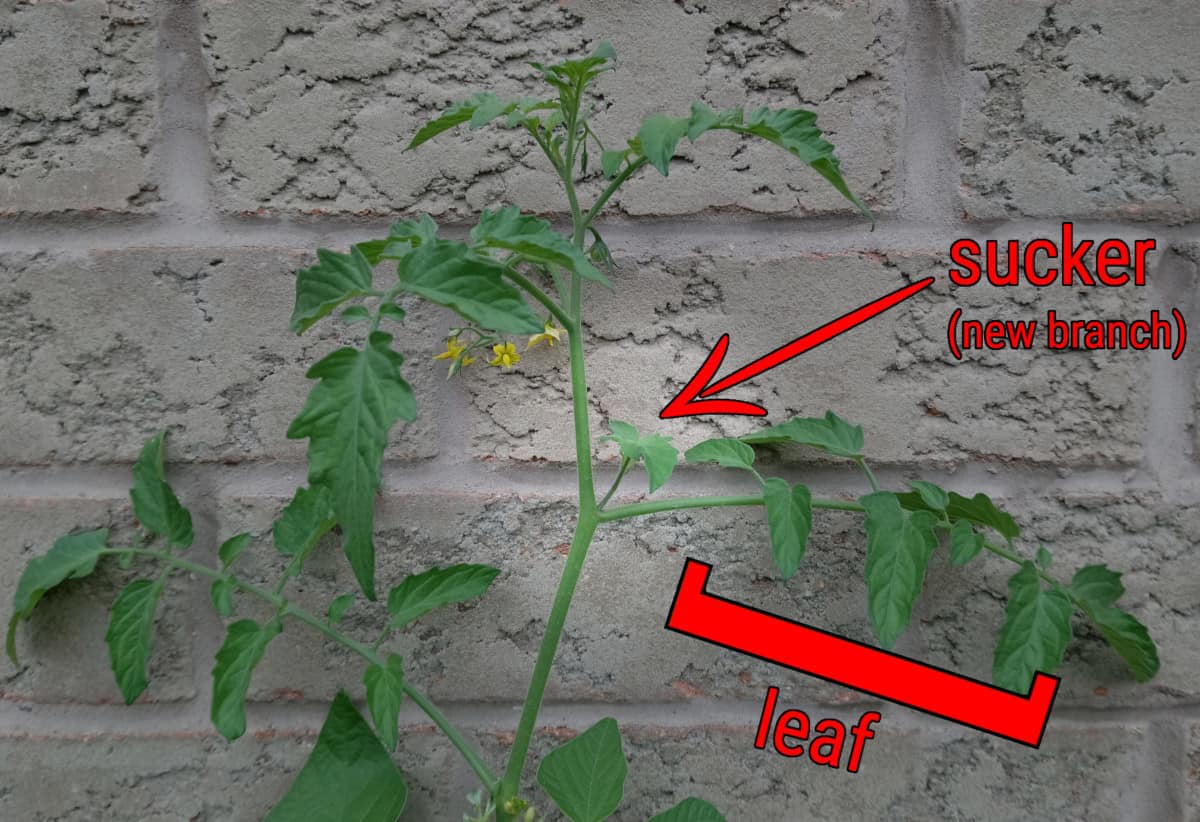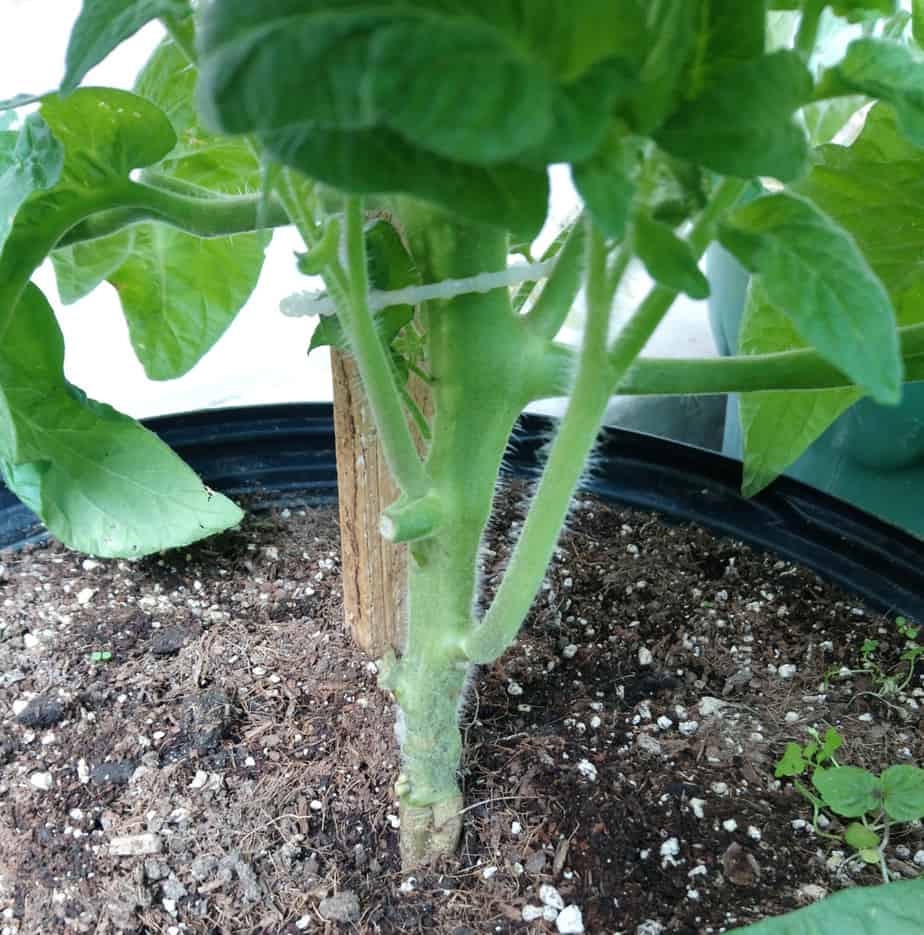Growing tomato plants in pots is a great way to start growing your own vegetables or make good use of your space on a deck, patio, or even a balcony. But tomato plants can be a bit daunting to grow for a lot of new gardeners and some experienced ones as well. They do take a bit of work, but depending what type of tomato you’re growing, you can get away with doing little maintenance.
On this page:
How to Prune Tomato Plants in Pots
Indeterminate tomato plants should be pruned regularly to control their growth, but determinate tomato plants can be left alone for the most part. At each node on a branch where a leaf grows out, there will be a shoot also growing out. These shoots are called suckers and can quickly grow into large branches with their own leaves, tomatoes, and side branches. Indeterminate tomatoes should have all or most of their suckers removed. After the midpoint of the season, or if an indeterminate tomato plant has already started overgrowing its pot, you can prune the tips of the branches so the plant can focus on ripening the tomatoes it already has.
How to Prune Indeterminate Tomatoes in Pots
Indeterminate tomato plants in pots need to be constantly pruned. First you want to decide how many suckers (side branches) you want to have on your tomato plant. For indeterminate tomatoes, I usually allow two or three side branches to grow so I can get a nice bush-like tomato plant, but a lot of people recommend just keeping it all to one single stem.
Whatever you decide, you will need to pinch off or cut off every sucker you can find, except the ones you want to keep. Check your tomato plants at least once a week, because when those tiny suckers reach a critical size, they start growing very fast.
When the side branches start growing and producing leaves and clusters of tomatoes of their own, you will also need to prune any suckers on them, too.

As your indeterminate tomato plant starts getting large, or you get about halfway through the season, you can start pruning the tips of your branches and main stem so the tomato plant stays the same size and focus on ripening the tomatoes it still has. In the ground, this is entirely optional, some people swear by it and others just let the tomato go wild in the last half of the summer, but in pots, it’s really important to do this because indeterminate tomato branches can easily grow 6 feet or longer.
Can You Prune Determinate Tomato Plants?
Determinate tomato plants are, by their nature, low maintenance tomato plants and they don’t need to be pruned at all. You can do minor pruning of the lower leaves near or on the soil, but pruning actual tomato-bearing branches will reduce your overall yield because determinate tomatoes don’t keep producing fruit all season.
How to Prune Determinate Tomatoes in Pots
Determinate (bush) tomatoes do not really need to be pruned, but if your tomato plants are getting too large for the pot and you don’t want to risk transplanting a mature tomato plant, it can sometimes be a good idea to prune the branches similar to indeterminate tomatoes.
But I still recommend pruning the bottom leaves, especially any that are touching or very close to the soil level.
Treat dwarf and semi-determinate tomato plants the same way you would determinate tomato plants.

When and Why You Should Prune Tomato Plants in Pots
If you’re growing indeterminate tomato plants, it’s highly recommended to prune them regularly. It’s not much work if you’re growing a few tomato plants, but it can take a lot of time every week if you’re growing dozens of them.
You can get away with not pruning them in the ground, it will just get wild and take up a lot of space (and you will probably have to hunt for tomatoes buried deep within the sprawling vines). But if you’re growing indeterminate tomato plants in pots, pruning is a must, as they will quickly get root-bound and require constant watering to keep them from wilting.
In addition, if your tomato plants are always suffering from a lack of water, they can suffer from blossom end rot, which is when the bottoms of your tomatoes start turning black and rotting. This is technically caused from a lack of calcium, which is important for fruit development, but a lack of water can have the same effect since roots can absorb calcium from dry soil.
Determinate tomato plants don’t need to be pruned, but there are a few situations when it’s a good idea. Pruning off the lower leaves as the tomato starts getting taller can help delay tomato blight and other diseases. Soil-borne diseases such as tomato blight can easily splash up to the leaves, infecting your plant and reducing your yield or even killing your tomato plants early.
Once my tomato plants are at least 3-4 feet tall, I make sure to use clean garden scissors or pruning shears to take off the bottom foot of leaves for in-ground tomato plants and bottom 4-6 inches for potted tomato plants.
What Types of Tomatoes Grow Best in Pots?
You can grow any tomato in a pot, but the tomato varieties best suited for container gardening are determinate and dwarf/semi-determinate varieties.
Indeterminate Tomatoes vs. Determinate Tomatoes
When buying plants or seeds at the nursery, you probably have noticed the terms indeterminate and determinate written on the labels of the tomato plants. What does it mean and why is it important to know when growing tomato plants in pots?
Indeterminate (Vine) Tomatoes
Most tomato varieties are indeterminate tomatoes. They grow almost like a vine, continually growing upwards while also producing long side branches. Look where the leaf meets the stem on an indeterminate tomato and you’ll find a little shoot, called a sucker. This will grow into a full branch with its own leaves and bunches of tomatoes (and more suckers).
Each branch will have its own side branches, and those side branches will also have their own side branches, and so on. An indeterminate tomato that doesn’t get pruned at all can quickly get out of control, which is why most people recommend pruning them at least a little bit.
The benefit of growing indeterminate tomatoes is that they keep producing tomatoes all season long, and will be productive and stay alive until disease or a frost kills them. My indeterminate tomatoes usually start getting disease sometime in late September, but they survive until my first frost in late October or early November.
Because indeterminate tomatoes keep growing, they are not ideal for pots unless you keep them constantly pruned to control growth. I’ve grown indeterminate tomatoes in pots a few times and they are a lot of work because those suckers can quickly get out of control if you’re not on top of pruning.
Determinate (Bush) Tomatoes
Determinate tomatoes also can grow side branches, but have a predetermined size and will produce most of their tomatoes all around the same time (over the course of several weeks or a month. While unpruned indeterminate tomatoes grow like a mess of vines, determinate tomatoes grow more like a bush.
The reason why some people prefer determinate tomatoes is that they require little to no pruning, are relatively low-maintenance, and also produce a lot of tomatoes in a short period of time. Because of this, a lot of these bush tomatoes are cultivated for market, like the Celebrity tomato.
Determinate tomatoes are also ideal for pots because they won’t outgrow the pot if it’s large enough (5 gallons up to 20 gallons).
What About Semi-Determinate and Dwarf Tomato Plants?
If you are buying seeds, you will occasionally find varieties labelled semi-determinate or sometimes dwarf. For all intents and purposes, treat them exactly like determinate tomatoes. They perform well in pots.
Semi-determinate tomatoes are indeterminate tomatoes that grow much more compact. In a short growing season, they look almost like determinate tomato plants, but given enough time, they can get as tall as an indeterminate tomato plant. Semi-determinate tomato plants also grow well in pots. A good example of a semi-determinate variety is the Marmande tomato.
Dwarf tomato plants are their own special category, but should also be treated like determinate tomatoes. Famed tomato expert and champion of dwarf tomatoes, Craig LeHoullier, describes dwarf tomatoes as being more like super compact semi-determinate tomatoes and will continue to grow and produce tomatoes if given enough time.
Dwarf tomatoes range from 6 inches tall up to 4 feet tall. They are associated with cherry tomatoes, like the Orange Hat tomato and Minibel tomato, but there are some dwarf tomatoes that produce full-sized fruit, like the Rosella Purple and Dwarf Stone tomato. They also are characterized by very dark green, firm, crinkly, potato-like leaves.
Pro-Tip: Suckers Can Be Used to Clone Your Tomato Plants
Since tomato plants easily grow roots out of their stem and branches, and suckers basically grow into full branches with their own leaves, tomatoes, and side branches, you can actually use suckers to propagate your tomato plants. Treat them like regular plant cuttings.
The best suckers to use are around 4 to 8 inches long; too short and they will either be buried or wash away when watered, too large and they can get overstressed since they need more water to sustain themselves.
There are two ways to propagate your tomato plants. The first is to take the cuttings (suckers) and place them in a glass with the bottom part of the stem in water indoors. When the roots start to grow out, you can transplant them in a pot or in the ground. The other way is to directly plant the sucker right into the pot or ground. Either way, it usually takes around 1-2 weeks until they start rooting.
I prefer the first method since the tomato cuttings stay out of the hot sun and have plenty of water to keep them alive until the roots start growing.
